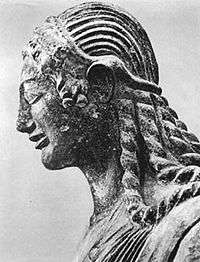Spina

Spina was an Etruscan port city, established by the end of the 6th century BCE,[1] on the Adriatic at the ancient mouth of the Po, south of the lagoon which would become the site of Venice. The site of Spina was lost until modern times, when drainage schemes in the delta of the Po River in 1922 first officially revealed a necropolis of Etruscan Spina about four miles west of the commune of Comacchio. The fishermen of Comacchio, it soon turned out, had been the source of "Etruscan" vases (actually originally imported from Greece) and other artifacts that had appeared for years on the archeological black market. The archaeological finds from the burials of Spina were discovered with the help of aerial photography. Aside from the white reflective surfaces of the modern drainage channels there appeared in the photographs a ghostly network of dark lines and light rectangles, the former indicating richer vegetation on the sites of ancient canals. Thus the layout of the ancient trading port was revealed, now miles from the sea, due to the sedimentation of the Po delta. Spina may have had a Hellenised indigenous population.[2]
References
- ↑ A.J. Graham, Colony and Mother City in Ancient Greece, 2009 (originally published in 1964). p.6.
- ↑ Mogens Herman Hansen and Thomas Heine Nielsen (2004). An Inventory of Archaic and Classical Poleis. ISBN 0-19-814099-1. In the index, p. 1390, Spina is labelled "Hell.?", where "Hell." stands for Hellenised indigenous community.
External links
- "Etruscan Engineering and Agricultural Achievements: The Ancient City of Spina"
- Discovery of a section of the Etruscan road that linked Spina with Lucca on the Tyrrhenian sea
Coordinates: 44°41′35″N 12°06′04″E / 44.6930555556°N 12.1011111111°E
